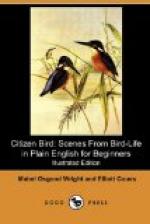“Do they stay around all the year?” asked Nat.
“Some of them do, but not many. They are very common in summer, but not as hardy as the Downies, and most of them go off south for the winter. They are very merry, frolicsome birds, with all sorts of tricks and manners—even Dodo’s Flickers are no jollier members of the Laughing Family.”
“Do they work when they are through playing?” asked Nat; “and do any good?”
“Yes, indeed,” answered the Doctor; “all kinds of Woodpeckers are industrious workers, and all of them except the Sapsuckers are very useful to us in destroying hurtful insects.”
“What kind of eggs do they lay?” asked Dodo; “it must be hard to get a look at them in such deep holes so high up.”
“Very pretty ones indeed,” replied the Doctor. “They are not very easy to reach, though you can readily see the rounded hole that leads into the nest, for it is almost always bored in a bare, dead part of the tree. I can show you some Woodpecker’s eggs in my cabinet. They are all alike, except in size—more round than most birds’ eggs are, very smooth and glossy, like porcelain, and pure white. But now write your table while that Red-head is still in sight. It is a very easy one; his colors are plain, and you can guess pretty nearly how long he is.”
The Red-headed Woodpecker
Length about nine inches.
Head and neck crimson-red all around; back and most of wings and tail glossy blue-black; all the rest snow-white, except a little red tinge on the belly.
Young ones gray whore the old ones are red, and not so pure black and white in other places.
A Citizen of the eastern half of the United States and some parts of Canada, but mostly going to the Southern States for the winter.
A good neighbor and useful member of the guilds of Tree Trappers and Ground Gleaners; he takes some of our fruits now and then, but is welcome to them for the good he does in destroying insects which would injure and perhaps kill our fruit trees if he did not eat his full share of them; and he has to work very hard to dig them out of the places where they lurk under the bark.
THE FLICKER
“The Flicker’s beak is more slender and curving than those of his brethren, and he has an extremely long, barbed tongue, which, he uses to probe ant-hills. The sticky substance in the bird’s mouth covers the little barbs on its tongue, and thus he is able to catch a great many ants at a time. He is one of our best ant-eaters.”
“Are ants very bad things if they don’t get into the sugar?” asked Dodo.
“There are a great many kinds of ants; though all may not be harmful, some of them do great damage by destroying timber or ripe fruit, and helping to spread lice about the roots of all sorts of plants.




